Passiflora tarminiana
| Passiflora tarminiana | |
|---|---|
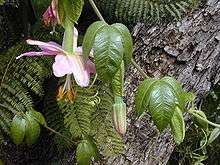 | |
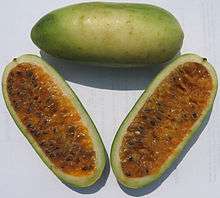 | |
| Scientific classification | |
| Kingdom: | Plantae |
| (unranked): | Angiosperms |
| (unranked): | Eudicots |
| (unranked): | Rosids |
| Order: | Malpighiales |
| Family: | Passifloraceae |
| Genus: | Passiflora |
| Subgenus: | Tacsonia |
| Species: | P. tarminiana |
| Binomial name | |
| Passiflora tarminiana Coppens & V.E.Barney | |
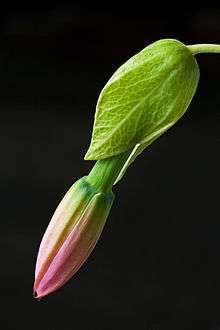
Passiflora tarminiana is a species of passionfruit. The yellow fruits are edible and their resemblance to small, straight bananas has given it the name banana passionfruit in some countries. It is native to the uplands of tropical South America and is now cultivated in many countries. In Hawaii and New Zealand it is now considered an invasive species.
P. tarminina belongs to the Tacsonia subgenus of Passiflora. It has been known under a number of different names and was only formally described in 2001.
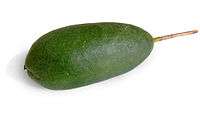
Description
Passiflora tarminina is a high climbing vine with hairy stems and petioles. Where the petioles join the stem it has stipules which are 4-7 by 2–3 mm and are soon deciduous. The leaves are three-lobed and hairy below but usually hairless above. The flowers are solitary and hang downwards. The base of the flower has pale green bracts enclosing a swollen nectary chamber. The floral tube (hypanthium) is 6-8 × 0.7–1 cm and pale green, while the sepals and petals are 3–6 cm long, pink and perpendicular to the floral tube, or reflexed. Fruits taper at both ends, are 10–14 cm long by 3.5-4.5 cm wide and ripen to yellow or light orange. The fruit contain many seeds which are embedded in an edible, orange aril.
P. tarminina is distinguished from P. tripartita var. mollissima by a number of features. P. tarminina has small deciduous stipules while P. tripartita var. mollissima has larger, persistent stipules. The sepals and petals in P. tarminina are perpendicular to the floral tube or are reflexed, whereas they are never so open in P. tripartita var. mollissima. They are also both much shorter in relation to the length of the floral tube in P. tripartita var. mollissima than in P. tarminina.
Taxonomy
The correct taxonomic placement of this species has been problematic for some years. In South America it has been considered under P. cumbalensis, P. mollissima or P. tripartita (the species which now includes P. mollissima), or as a hybrid.[1] In Hawaii it was referred to as P. mollissima.[2] In New Zealand it was included under P. mixta[3][4] although some sources also used the name P. mollissima for this species. It was described as a separate species distinct from any of these in 2001.[1] The specific name recognises the Colombian agronomist Tarmín Campos.
Common names for P. tarminiana include banana passionfruit (Australia, New Zealand, Africa, Hawaii), curuba India, curuba ecuatoriana, curuba quiteña (Colombia), tacso amarillo (Ecuador), tumbo (Perú), banana pōka (Hawaii) (in the Hawaiian language the word pōka'a refers to tendrils - "that which is tied up in a ball like rope or twine"), northern banana passionfruit (New Zealand).[5]
Distribution
P. tarminiana is native to the uplands of tropical South America but the exact native range is uncertain as it has been widely cultivated in this region. It is found in the Colombian highlands and the Venezuelan, Peruvian and southern Ecuadorean Andes where it is cultivated from around 2000 – 3000 metres.[1] It has naturalised in Australia, Guam, Hawaii, New Zealand and Zimbabwe. In both Hawaii and New Zealand it is regarded as an invasive species.[2][4]
It is widely cultivated throughout the world, including California, Réunion, Mexico, Panama and Papua New Guinea.[1]
Biology
In the original description Passiflora tarminina is described as a cultigen and there is little information about its biology in the wild. Many members of the subgenus Tacsonia are restricted endemics and it is unclear whether the widely cultivated species (such as P. tarminiana) are also local endemics which have been spread through widespread cultivation or whether they are naturally widespread species.[2] The type specimen is from a cultivated rather than a wild plant.[1]
Unlike many Passiflora species, P. tarminiana is self-compatible, although self-pollination is not considered important in the wild. The main pollinators in South America are believed to be hummingbirds or large bees, while in Hawaii birds were commonly observed robbing nectar but not transferring pollen. Bees and other insects were observed collecting pollen in Hawaii.[2]
In Hawaii the seeds are dispersed by frugivorous animals. By far the most important disperser in Hawaii is the feral pig, which eats the fallen fruit and passes the seeds intact. Feral pigs seek out the fruit and when P. tarminiana occurs with feral pigs in Hawaii, the seeds are abundant in pig droppings. Germination is not enhanced by gut passage but pigs disturb the ground making a more favourable environment for germination of P. tarminiana. Because their home range is typically one to two square miles, pigs contribute more to the peripheral expansion of P. tarminiana patches than long distance dispersal.[2]
P. tarminiana invades both open and closed forest in Hawaii. It grows most rapidly in full sun but tolerates some shade. Growth is severely restricted at relative light intensities of less than 2%. Where the forest canopy is largely intact, P. tarminiana invades in canopy gaps formed when trees fall or die.[2]
P. tarminiana hybridises with other members of the subgenus Tacsonia.[1]
Uses
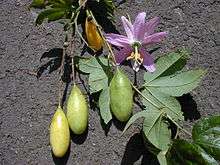
Passiflora tarminiana is cultivated for its edible fruit. It is the second most common species in cultivation in South America after P. tripartita var. mollissima and is considered more disease resistant than that species.[1] The fruit are also eaten in New Zealand but in Hawaii the fruit is considered to be insipid.
The pink flowers are showy and it is also considered to be an ornamental species.
Control
Three biological control agents have been released in Hawaii for the control of Passiflora tarminiana. Septoria passiflorae, a fungus, was released in 1996. There have been major epidemics that have substantially reduced the biomass of P. tarminiana.[6] This fungus requires wind and rain to spread and in some areas requires repeated inoculations to achieve control.[5] Two moth species were also introduced, Cyanotricha necryia, which failed to establish, and Pyrausta perelegans, which suffered substantial levels of egg parasitism and has not become common.[7]
Physical and chemical control methods have generally proved to be ineffective and uneconomic in Hawaii, although glyphosate has been successfully used to control P. tarminiana in Acacia koa forest.[8]
P. tarminiana is controlled by land management agencies in some areas of New Zealand. Control is either by physical control (for example hand pulling of seedlings) or using herbicides.[9] Biological control research is underway in New Zealand. The Septoria species from Hawaii was tested in containment in New Zealand and found to damage Passiflora edulis which is grown commercially.[10] Pyrausta perelegans is undergoing host range testing.[11]
References
- 1 2 3 4 5 6 7 Coppens d'Eeckenbrugge, G.; Barney, V.E.; Jørgensen, P.M.; MacDougal, J.M. (2001). "Passiflora tarminiana, a new cultivated species of Passiflora subgenus Tacsonia (Passifloraceae)." (PDF). Novon. Novon, Vol. 11, No. 1. 11 (1): 8–15. doi:10.2307/3393199. JSTOR 3393199. Cite uses deprecated parameter
|coauthors=(help) - 1 2 3 4 5 6 LaRosa A.M. (1984). "The biology & ecology of Passiflora mollissima in Hawaii.". Cooperative National Park Resources Studies Unit, University of Hawaii, Department of Botany. Technical Report 50.
- ↑ Webb, C.J.; Sykes, W.R.; Garnock-Jones, P.J. (1988). The Flora of New Zealand: volume IV naturalised Pteridophytes, Gymnosperms, Dicotyledons. Christchurch, New Zealand: Botany Division Department of Scientific and Industrial Research. ISBN 0-477-02529-3.
- 1 2 Heenan, P.B.; Sykes, W.R. (2003). "Passiflora (Passifloraceae) in New Zealand: a revised key with notes on distribution". New Zealand Journal of Botany. 41 (2): 217–221. doi:10.1080/0028825X.2003.9512842.
- 1 2 Hawaii Department of Agriculture (2006). "Banana poka". Plant Pest Control Section Annual Report. Retrieved 2007-08-18.
- ↑ Trujillo, E.E. (2005). "History and success of plant pathogens for biological control of introduced weeds in Hawaii". Biological Control. 33 (1): 113–122. doi:10.1016/j.biocontrol.2004.11.008.
- ↑ Campbell, C. L.; Markin, G. P.; Johnson, M. W. (1993). "Fate of Cyanotricha necyria (Lepidoptera: Notodontidae) and Pyrausta perelegans (Lepidoptera: Pyralidae) released for biological control of banana poka (Passiflora mollissima) on the island of Hawai'i". Proceedings of the Hawaiian Entomological Society. 32: 123–130.
- ↑ Starr, F.; Starr, K. Loope, L. (2003). "Passiflora mollisima" (PDF). Cite uses deprecated parameter
|coauthors=(help) - ↑ Department of Conservation (2002). "Banana passionfruit".
- ↑ Landcare Research (2005). "Infidelity Ends Hopes of a Passion-Filled Relationship" (PDF). What's new in biological control of weeds?. 34. Retrieved 2007-08-18.
- ↑ Landcare Research (2006). "Colombian Courier Delivers Precious Package" (PDF). What's new in biological control of weeds?. 38. Retrieved 2007-08-18.
External links
| Wikimedia Commons has media related to Passiflora tarminiana. |